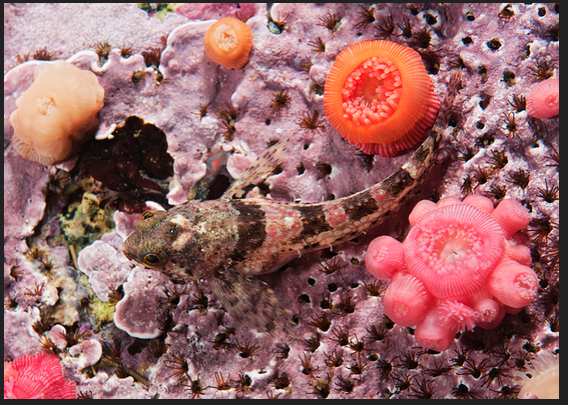Sculpin have ability to blend in with their surroundings which is useful in escaping from enemies and in capturing their prey by ambush. The body is elongate, its depth about 10cm. Head somewhat depressed, its length about 6cm. The snout is blunt in profile and It is moderate in size, the upper jaw extending to mid-pupil.
The species is very abundant in tide pools around rocky the rocky shores of Race Rocks. Tide pool sculpins show a definite tendency to return to their home pool if moved. These are very abundant in the tidepools on the north east corner of Great Race Rock. A piece of edible tissue dropped into a pool usually causes a feeding frenzy.
Domain Eukarya
Kingdom Animalia
Phylum Chordata
Subphylum Vertebrata
Class Actinopterigii
Order Scorpaeniformes
Sub Order Cottoidei
Family Cottidae
Genus Oligocottus
Species maculosus
Common Name: Tidepool Sculpin
Ryan Murphy took the following photos of Sculpins when he was stationed at Race Rocks as the Ecoguardian . He was able to dive frequently while there and developed an excellence in underwater photography.
His photographs can be viewed on his Flickr site:
We have not been able to identify all the following yet so are including them all with the tidepool sculpin: Oligocottus maculosus
Other Members of the Class Actinopterigii at Race Rocks.
and Image File |
 The Race Rocks taxonomy is a collaborative venture originally started with the Biology and Environmental Systems students of Lester Pearson College UWC. It now also has contributions added by Faculty, Staff, Volunteers and Observers on the remote control webcams. original file : Dec 2002, by Abdul Mobin.(PC) The Race Rocks taxonomy is a collaborative venture originally started with the Biology and Environmental Systems students of Lester Pearson College UWC. It now also has contributions added by Faculty, Staff, Volunteers and Observers on the remote control webcams. original file : Dec 2002, by Abdul Mobin.(PC) |






















